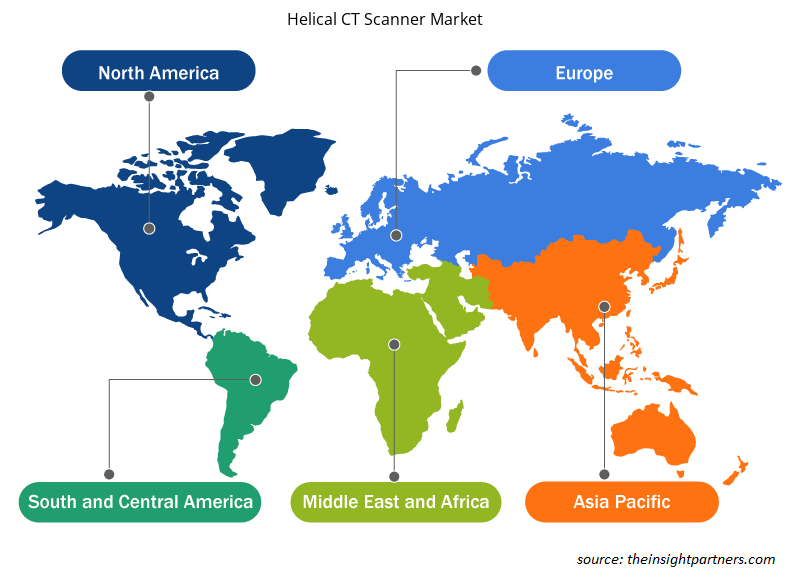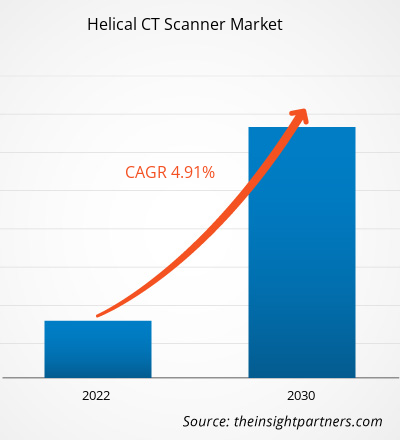[Research Report] The helical CT scanner market value is projected to grow from US$ 842.35 million in 2022 to US$ 1,236.29 million by 2030; the market is anticipated to record a CAGR of 4.91% from 2022 to 2030.
Market Insights and Analyst View:
The helical CT scanner market forecast presented in this report can help stakeholders in this marketplace plan their growth strategies.
Helical CT scanners, or spiral CT scanners, are advanced medical imaging devices that utilize a helical scanning method to produce detailed cross-sectional images of the body. With a rising prevalence of chronic diseases and cardiovascular disorders, the need for precise and efficient diagnostic tools, such as helical CT scanners, is also on the rise. Unlike traditional CT scanners, helical scanners feature a continuous rotation of the X-ray source and detectors around the patient.
Increasing focus on advanced imaging capabilities and the demand for higher spatial resolution with faster scan time in diagnostic imaging are the key factors driving the helical CT scanner market growth. Moreover, continuous data acquisition by these scanners allows the generation of high-resolution three-dimensional images, enabling enhanced visualization of internal structures. Ongoing technological advancements in detector technologies, dose reduction techniques, and image reconstruction algorithms continue to improve the performance and safety of helical CT scanners. Helical CT scanner market trends include the integration of artificial intelligence and machine learning in helical CT scanners.
Growth Drivers and Challenges:
Increased Prevalence of Chronic Diseases Fuels Helical CT Scanner Market
A rise in incidences of cardiovascular disorders, cancer, and neurological conditions triggers the need for advanced diagnostic imaging tools capable of providing detailed and precise visualizations of internal anatomical structures. According to the National Center for Health Statistics, ~1.9 million new cancer cases were reported in the US in 2021. Computed tomography is one of the reliable imaging techniques used in cancer diagnoses. As per an article published by Harvard Health in September 2021, nearly 90.0 million CT scan procedures are performed in the US annually. Furthermore, the National Cancer Institute (NCI) reports that the National Lung Screening Trial (NLST), funded by the NCI, revealed that individuals aged 55–74 with a history of heavy smoking have a 20% lower risk of dying from lung cancer after being screened with low-dose helical CT than those who are screened with standard chest X-rays. It is believed that people who have never used tobacco products have too low a chance of developing lung cancer to benefit from lung cancer screening.
With their ability to capture comprehensive 3D images providing dynamic cross-sectional views, helical CT scanners play a pivotal role in diagnosing, staging, and monitoring these diseases. Their versatility and broad applications across various clinical specialties make them indispensable in detecting tumors, assessing vascular conditions, and overall diagnostic imaging. As the burden of cancer and other chronic diseases increases, the demand for precise and efficient diagnostic solutions provided by helical CT scanners becomes ever more pronounced. Thus, the increasing prevalence of chronic diseases and complex medical conditions bolsters the helical CT scanner market size.
Substantial initial investments are required to acquire and install these advanced imaging systems. As a result, many healthcare facilities, especially those from cost-sensitive countries or those with limited financial resources, show reluctance toward adopting this equipment. The high capital expenditure includes the procurement of the scanner, and the costs associated with site planning, infrastructure modifications, installation, and staff training. Additionally, maintenance, upgrades, and personnel training expenses contribute to the total cost of ownership. Such financial commitments have often posed challenges for healthcare providers, particularly in smaller clinics and facilities, in adopting helical CT scanners, which limits their widespread availability and accessibility. Efforts made to address the cost barrier may involve exploring financing options, cost-effective purchasing models, and collaborative partnerships to make these essential diagnostic tools more attainable for a wider range of healthcare settings. Nevertheless, the high installation cost associated with these scanning systems hinders the helical CT scanner market growth.
Customize This Report To Suit Your Requirement
You will get customization on any report - free of charge - including parts of this report, or country-level analysis, Excel Data pack, as well as avail great offers and discounts for start-ups & universities
Helical CT Scanner Market: Strategic Insights

- Get Top Key Market Trends of this report.This FREE sample will include data analysis, ranging from market trends to estimates and forecasts.
Customize This Report To Suit Your Requirement
You will get customization on any report - free of charge - including parts of this report, or country-level analysis, Excel Data pack, as well as avail great offers and discounts for start-ups & universities
Helical CT Scanner Market: Strategic Insights

- Get Top Key Market Trends of this report.This FREE sample will include data analysis, ranging from market trends to estimates and forecasts.
Report Segmentation and Scope:
The helical CT scanner market analysis has been carried out by considering the following segments: based on type, slice type, and end user. By type, the market is bifurcated into double-layer and multilayer. Based on slice type, the market is divided into 1-16 Slices, 17-64 Slices,128-160 Slices, and >160 Slices. By end user, the market is segmented into hospitals, medical centers, and ambulatory surgical centers. Based on geography, the helical CT scanner market is segmented into North America (US, Canada, and Mexico), Europe (UK, Germany, France, Italy, Spain, and Rest of Europe), Asia Pacific (China, Japan, India, Australia, South Korea, and Rest of Asia Pacific), the Middle East & Africa (UAE, Saudi Arabia, South Africa, and Rest of Middle East & Africa), and South & Central America (Brazil, Argentina, and Rest of South & Central America).
Segmental Analysis:
Type-Based Insights
Based on type, the helical CT scanner market is segmented based on type into double-layer and multi-layer stationary and portable CT scanners. the multi-layer segment held a larger helical CT scanner market share in 2022. It is anticipated to register a higher CAGR during 2022–2030.
Slice Type-Based Insights
The helical CT scanner market, based on slice type, is bifurcated into 1-16 Slices, 17-64 Slices,128-160 Slices, and >160 Slices. 17-63 Slices segment is anticipated to hold a significant share by 2030.
End User-Based Insights
In terms of end users, the helical CT scanner market is categorized into hospitals, medical centers, and ambulatory surgical centers. In terms of end users, the hospital's segment held the largest helical CT scanner market share in 2022. It is anticipated to register the highest CAGR during 2022–2030.
Helical CT Scanner Market Regional Insights
Helical CT Scanner Market Regional Insights
The regional trends and factors influencing the Helical CT Scanner Market throughout the forecast period have been thoroughly explained by the analysts at Insight Partners. This section also discusses Helical CT Scanner Market segments and geography across North America, Europe, Asia Pacific, Middle East and Africa, and South and Central America.

- Get the Regional Specific Data for Helical CT Scanner Market
Helical CT Scanner Market Report Scope
| Report Attribute | Details |
|---|---|
| Market size in 2022 | US$ 842.35 Million |
| Market Size by 2030 | US$ 1,236.29 Million |
| Global CAGR (2022 - 2030) | 4.91% |
| Historical Data | 2020-2022 |
| Forecast period | 2022-2030 |
| Segments Covered |
By Type
|
| Regions and Countries Covered | North America
|
| Market leaders and key company profiles |
Helical CT Scanner Market Players Density: Understanding Its Impact on Business Dynamics
The Helical CT Scanner Market market is growing rapidly, driven by increasing end-user demand due to factors such as evolving consumer preferences, technological advancements, and greater awareness of the product's benefits. As demand rises, businesses are expanding their offerings, innovating to meet consumer needs, and capitalizing on emerging trends, which further fuels market growth.
Market players density refers to the distribution of firms or companies operating within a particular market or industry. It indicates how many competitors (market players) are present in a given market space relative to its size or total market value.
Major Companies operating in the Helical CT Scanner Market are:
- Canon Medical Systems Corporation
- Trinity Exim Limited
- Fujifilm Holdings
- GE Healthcare
- Carl Zeiss AG
Disclaimer: The companies listed above are not ranked in any particular order.

- Get the Helical CT Scanner Market top key players overview
Regional Analysis:
In terms of geography, the scope of the helical CT scanner market report encompasses North America, Europe, Asia Pacific, the Middle East & Africa, and South & Central America. North America held the largest share of the helical CT scanner market in 2022, and it is projected to maintain its dominance (in terms of share) during the forecast period. The market in North America is segmented into the US, Canada, and Mexico. The US holds the largest share of the market in North America and the world. Market growth in this country is ascribed to the increase in the prevalence of inflammatory diseases, the presence of major market players, continued advancements in the healthcare sector, access to innovative helical CT scan systems, and developments in CT scan technology.
Competitive Landscape and Key Companies:
Canon Medical Systems Corporation, Trinity Exim Limited, Fujifilm Holdings, GE Healthcare, Carl Zeiss AG, Philips, Shenzhen Anke, Shimadzu Corporation, Siemens AG, and SternMed GmbH are a few key companies profiled in the helical CT scanner market report. These companies focus on expanding their offerings to meet the growing consumer demand worldwide. Their global presence allows them to serve many customers, subsequently allowing them to expand their market presence.
- Historical Analysis (2 Years), Base Year, Forecast (7 Years) with CAGR
- PEST and SWOT Analysis
- Market Size Value / Volume - Global, Regional, Country
- Industry and Competitive Landscape
- Excel Dataset



Report Coverage
Revenue forecast, Company Analysis, Industry landscape, Growth factors, and Trends

Segment Covered
Type, Slice Type, End User, and Geography

Regional Scope
North America, Europe, Asia Pacific, Middle East & Africa, South & Central America

Country Scope
This text is related
to country scope.
Frequently Asked Questions
Increasing focus on advanced imaging capabilities and the demand for higher spatial resolution are the key factors driving the the helical CT scanner market growth. Furthermore, helical CT scanner market trends include increasing adoption of AI (Artificial Intelligence) and ML (Machine Learning) in helical CT scanners.
The helical CT scanner market is segmented based on type into double-layer and multi-layer stationary and portable CT scanners. The multi-layer segment held a larger market share in 2022 and is anticipated to register the highest CAGR during 2022–2030.
The helical CT scanner market, based on slice type, is bifurcated into 1-16 Slices 17-64 Slices,128-160 Slices, and >160 Slices. 17-63 Slices segment is anticipated to hold a significant helical CT scanner market share by 2030.
Helical CT scanners, or spiral CT scanners, are advanced medical imaging devices that utilize a helical scanning method to produce detailed cross-sectional images of the body. Unlike traditional CT scanners, helical scanners feature a continuous rotation of the X-ray source and detectors around the patient. In contrast, the patient table moves through the scanner in a helical or spiral path. This continuous data acquisition allows for the creation of high-resolution three-dimensional images, enabling enhanced visualization of internal structures.
The helical CT scanner market was valued at US$ 842.35 million in 2022.
The helical CT scanner market has major market players, including Canon Medical Systems Corporation, Trinity Exim Limited, Fujifilm Holdings, GE Healthcare, Carl Zeiss AG, Philips, Shenzhen Anke, Shimadzu Corporation, Siemens AG, and SternMed GmbH.
The helical CT scanner market is expected to be valued at US$ 1,236.29 million in 2030.
Trends and growth analysis reports related to Life Sciences : READ MORE..
The List of Companies - Helical CT Scanner Market
- Canon Medical Systems Corporation
- Trinity Exim Limited
- Fujifilm Holdings
- GE Healthcare
- Carl Zeiss AG
- Philips
- Shenzhen Anke
- Shimadzu Corporation
- Siemens AG
- SternMed GmbH

 Get Free Sample For
Get Free Sample For